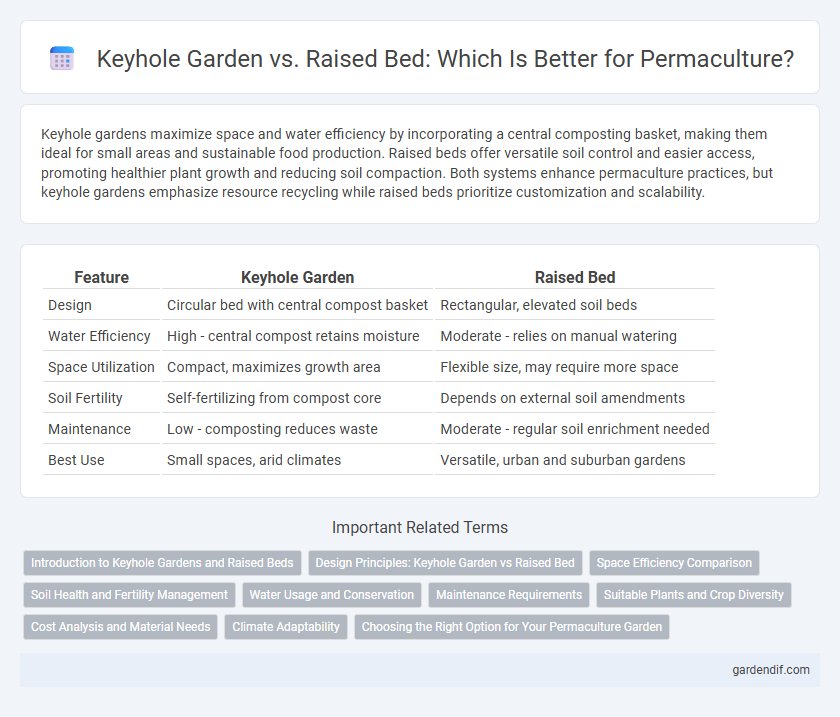
Keyhole Garden vs Raised Bed Illustration
Keyhole gardens maximize space and water efficiency by incorporating a central composting basket, making them ideal for small areas and sustainable food production. Raised beds offer versatile soil control and easier access, promoting healthier plant growth and reducing soil compaction. Both systems enhance permaculture practices, but keyhole gardens emphasize resource recycling while raised beds prioritize customization and scalability.
Table of Comparison
| Feature | Keyhole Garden | Raised Bed |
|---|---|---|
| Design | Circular bed with central compost basket | Rectangular, elevated soil beds |
| Water Efficiency | High - central compost retains moisture | Moderate - relies on manual watering |
| Space Utilization | Compact, maximizes growth area | Flexible size, may require more space |
| Soil Fertility | Self-fertilizing from compost core | Depends on external soil amendments |
| Maintenance | Low - composting reduces waste | Moderate - regular soil enrichment needed |
| Best Use | Small spaces, arid climates | Versatile, urban and suburban gardens |
Introduction to Keyhole Gardens and Raised Beds
Keyhole gardens are circular raised beds with a central compost basket designed to enhance soil fertility and water efficiency, commonly used in permaculture for their space-saving and nutrient-recycling benefits. Raised beds are elevated planting areas that improve drainage, soil structure, and root growth by providing loose, nutrient-rich soil, ideal for optimizing crop yields in small-scale sustainable gardening. Both gardening methods promote sustainable land use by maximizing productivity and minimizing resource inputs, making them essential in permaculture design.
Design Principles: Keyhole Garden vs Raised Bed
Keyhole gardens optimize space with a circular layout centered around a composting basket, promoting nutrient recycling and efficient water use, ideal for permaculture systems emphasizing sustainability. Raised beds, featuring rectangular, elevated soil areas, enhance soil drainage, temperature control, and accessibility while allowing precise planting arrangements. Both designs leverage permaculture principles such as resource cycling and ecological function but differ in spatial organization and maintenance approaches.
Space Efficiency Comparison
Keyhole gardens maximize space by incorporating a central composting basket, allowing nutrients to recycle efficiently within a circular design that typically measures 6 to 8 feet in diameter. Raised beds offer modular flexibility and can be arranged in various layouts, but often require more pathways and spacing, reducing overall planting area in compact gardens. The keyhole garden's compact footprint and integrated nutrient recycling make it more space-efficient for small-scale permaculture setups compared to traditional raised bed systems.
Soil Health and Fertility Management
Keyhole gardens optimize soil health through a central compost basket that continuously recycles nutrients, enhancing fertility and microbial activity. Raised beds offer controlled soil conditions with improved drainage and aeration, facilitating targeted amendments for sustained nutrient availability. Both systems promote rich, biologically active soil but differ in nutrient delivery dynamics and maintenance approaches.
Water Usage and Conservation
Keyhole gardens maximize water efficiency through their central compost basket, which enhances soil moisture retention and reduces runoff. Raised beds improve water conservation by using well-defined soil profiles and mulching to minimize evaporation and optimize water absorption. Both designs support sustainable water use but keyhole gardens excel in recycling nutrients and moisture in arid climates.
Maintenance Requirements
Keyhole gardens require less frequent watering due to their central compost basket that retains moisture and nutrients, reducing overall maintenance compared to raised beds. Raised beds often need regular soil amendments and vigilant watering schedules to maintain plant health and productivity. Both gardening methods benefit from mulching, but keyhole gardens provide a more self-sustaining system with lower daily upkeep.
Suitable Plants and Crop Diversity
Keyhole gardens support a wide variety of herbs, leafy greens, and root vegetables due to their efficient water retention and nutrient distribution. Raised beds accommodate a broader range of crops, including larger fruiting plants like tomatoes and peppers, thanks to their greater soil depth and improved drainage. Both methods enhance crop diversity, but keyhole gardens favor compact, moisture-loving plants while raised beds suit diverse planting needs and crop rotations.
Cost Analysis and Material Needs
Keyhole gardens typically require less material due to their compact, circular design with a central composting basket, reducing soil, wood, and irrigation costs compared to raised beds. Raised beds demand more lumber or brick, soil amendments, and structural supports, increasing the initial investment and material requirements. Cost analysis reveals keyhole gardens offer a budget-friendly option with efficient resource use, while raised beds may provide larger planting areas at higher expenses.
Climate Adaptability
Keyhole gardens excel in hot, arid climates by retaining moisture through central composting, while raised beds offer better drainage and soil control ideal for cooler, wetter regions. The circular design of keyhole gardens maximizes microclimates, enhancing heat retention and reducing water evaporation. Raised beds allow for seasonal soil amendments and insulation, making them adaptable to varied temperature fluctuations.
Choosing the Right Option for Your Permaculture Garden
Keyhole gardens maximize space and water efficiency by combining circular design with a composting central basket, ideal for permaculture zones with limited water and nutrient recycling needs. Raised beds offer greater control over soil quality and drainage, making them suitable for permaculture setups requiring specific plant groupings and soil amendments. Selecting between keyhole gardens and raised beds depends on factors such as available space, local climate, water availability, and the gardener's focus on sustainable resource management.
Keyhole Garden vs Raised Bed Infographic

 gardendif.com
gardendif.com